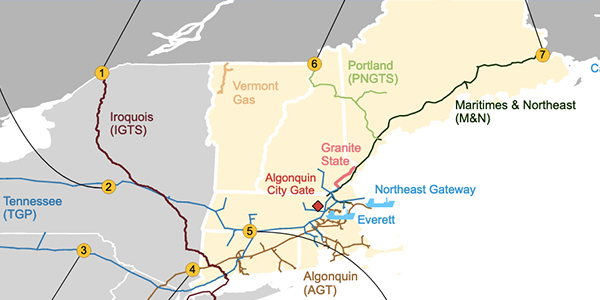By Michael Kuser
A new ISO-NE whitepaper attempts to chart a course for the RTO to develop new market-based solutions to overcome New England’s long-term energy security challenges.
The RTO issued the whitepaper to the New England Power Pool Markets Committee just a week after filing an interim proposal with FERC to address winter energy security for the commitment periods covered by Forward Capacity Auction 14 (2023/24) and FCA 15 (2024/25).
The nearly 400-page interim plan calls for a voluntary two-year program to “provide incremental compensation to resources that maintain inventoried energy during cold periods when winter energy security is most stressed” (ER19–1428).
The RTO made the filing despite last month’s rejection of the proposal by the NEPOOL Participants Committee. Members also rejected a proposal by energy services firm Energy New England (ENE) that would have limited compensation to oil-fired and certain natural gas-fired resources, demand response and electric storage resources. (See ISO-NE Steady on Fuel Plan Despite NEPOOL Rebuff.)
Pulling the Trigger
The RTO’s interim program consists of five core components, including a two-settlement structure, a forward rate, a spot rate, trigger conditions and a maximum duration for compensation.
Under the proposal’s two-settlement structure, resources would be paid or charged for deviations between the forward rate of $82.49/MWh for inventoried energy purchased in a forward position for the entire winter season and the spot settlement rate — $8.25/MWh — representing energy maintained during each trigger condition.
An “inventoried energy day” under the program is triggered for any day in December, January or February when the average of the high and low temperatures on that day, as measured at Bradley International Airport in Connecticut, is less than or equal to 17 degrees Fahrenheit.
The program’s maximum duration of 72 hours of generator compensation is designed to account for the incremental reliability benefit of another megawatt-hour of inventoried energy, decreasing as a resource maintains a greater quantity of inventoried energy, according to the filed testimony of Christopher Geissler, the RTO’s market development economist.
Adding another megawatt-hour of inventoried energy to a resource able to operate for 12 hours may improve the region’s winter energy security; however, if a resource has enough inventoried energy to operate for six months, then adding another megawatt-hour of inventoried energy “is unlikely to have a material effect,” Geissler testified.
Todd Schatzki, vice president of Analysis Group, testified on behalf of the RTO and estimated the program’s costs at $148 million per year, corresponding to approximately 1.8 million MWh of inventoried energy sold forward and maintained during trigger cold days throughout the winter.
“As these assumptions reflect maximum program participation, in a sense, this estimate provides an upper bound on the program’s potential costs, assuming forward settlement of all inventoried energy and no change in the region’s infrastructure,” Schatzki said.
Program participation may differ from assumptions, he said. For example, through lower-than-expected LNG contracting, resources may not supply the maximum eligible quantity of inventoried energy into the program, or resources may supply only a fraction of their capacity through forward settlement, which could lead to higher or lower payments if the number of very cold days differs from the number assumed in setting the forward settlement rate.
Fast and Easy, or Not
FERC in December approved the RTO’s initial Tariff revisions to use an out-of-market mechanism to address concerns about fuel security, filed after the commission in July denied a Tariff waiver to allow the RTO to enter a cost-of-service agreement to keep Exelon’s 2,274-MW Mystic plant running after its capacity obligations expire in May 2022.
The commission encouraged “ISO-NE to work with all interested parties, including NEPOOL, to continue to address their areas of disagreement while developing the long-term market solution.” (See ISO-NE Fuel Security Measures Approved.)
Ahead of NEPOOL discussions over the next six months on a long-term solution, the interim program first had to be simple enough to be designed and filed quickly, and not overly complex to implement, the RTO said.
Second, to be effective, the program should compensate resources that provide winter energy security. And third, “it should be designed consistent[ly] with sound market design principles, most notably providing similar compensation for similar service,” Geissler said.
Looking Ahead
The RTO’s whitepaper now looks at the region’s needs beyond FCA 15. To accommodate the complexity needed in a long-term solution, the document broadly recommends “expanding the existing suite of energy and ancillary service products” in the markets to address “the uncertainties and supply limitations inherent to a power system evermore reliant on just-in-time energy technologies.”
Three core components intended to spur discussion are a multi-day ahead market, new ancillary services in the day-ahead market and a seasonal forward market.
The first would optimize energy, including stored fuel energy, over a multi-day timeframe and produce multi-day clearing prices for market participants’ energy obligations.
The second component would create several new, voluntary ancillary services in the day-ahead market to provide, and compensate for, the flexibility of on-demand energy.
The seasonal forward market would see the RTO conduct a voluntary, competitive forward auction to incent and compensate asset owners to invest in supplemental supply arrangements for the coming winter, the whitepaper said.
Referring to the paper, Marcia Blomberg, ISO-NE’s senior media relations specialist, said: “The ISO committed to posting this by April 1 to give stakeholders a basis for discussion as we work with them to refine the proposal to be filed at FERC by Oct. 15.”





